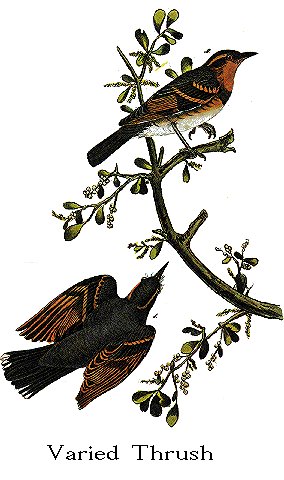
| Family XII. TURDINAE. THRUSHES. GENUS III. TURDUS, Linn. THRUSH. |
Next >> |

Family |
VARIED THRUSH. [Varied Thrush.] |
| Genus | TURDUS NAEVIUS, Gmel. [Ixoreus naevius.] |
Of this beautiful Thrush, of which a figure not having the black band running quite across the breast, as is the case in the adult male, is given by
Mr. SWAINSON, in the Fauna Boreali-Americana, Dr. RICHARDSON speaks as
follows:--"This species was discovered at Nootka Sound, in Captain Cook's third
voyage, and male and female specimens, in the possession of Sir JOSEPH BANKS,
were described by LATHAM: PENNANT has also described and figured the same male.
The specimen represented in this work was procured at Fort Franklin, lat.
65 1/4 degrees, in the spring of 1826. We did not hear its song, nor acquire
any information respecting its habits, except that it built its nest in a bush,
similar to that of the Merula migratoria. It was not seen by us on the banks of
the Saskatchewan; and, as it has not appeared in the list of the Birds of the
United States, it most probably does not go far to the eastward of the Rocky
Mountains in its migrations north and south. It may perhaps be more common to
the westward of that ridge."
Dr. RICHARDSON's conjecture as to the line of march followed by it has
proved to be correct, Mr. TOWNSEND and Mr. NUTTALL having found it abundant on
the western sides of the Rocky Mountains. The former of these naturalists
informs me that he "first found this Thrush on the Columbia river in the month
of October, and that it becomes more numerous in winter, which it spends in that
region, though some remove farther south. It there associates with the Common
Robin, Turdus migratorius, but possesses a very different note, it being louder,
sharper, and quicker than those of the latter, and in the spring, before it sets
out for its yet unascertained breeding-place, it warbles very sweetly. It is
called Ammeskuk by the Chinooks."
Mr. NUTTALL'S notice respecting it is as follows:--"Of this bird, whose
manners so entirely resemble those of the Common Robin, we know almost nothing.
They probably breed as far north as Nootka, where they were first seen by the
naturalists of COOK'S expedition. On the Columbia they are only winter birds of
passage, arriving about October, and continuing more or less frequently
throughout the winter. At this time they flit through the forest in small
flocks, frequenting usually low trees, on which they perch in perfect silence,
and are at times very timorous and difficult of approach, having all the shy
sagacity of the Robin, and appearing at all times in a very desultory manner."
The numerous specimens of this Thrush in my possession have enabled me to
compare it with Turdus migratorius, and another new Thrush from Chili. On
examining the tail, from the shape of which Mr. SWAINSON considers this species
allied to our Mocking-bird, I found its form, length, and extent beyond the
wings, to correspond almost exactly with those of the tail of our Robin; and, if
it proves true that the Varied Thrush forms a nest bedded with mud, it will
strengthen my opinion that both these and the Chilian species are as nearly
allied as possible, and therefore ought to be considered as true Thrushes, of
which Turdus migratorius is the type in America, whilst Turdus Merula is that of
Europe.
The figures in my plate were taken from adult males and a fine female shot
in spring.
ORPHEUS MERULOIDES, Thrush-like Mocking-bird, Swains. and Rich. F. Bor.
Amer., vol. ii. p. 187.
VARIED THRUSH, Turdus naevius, Aud. Orn. Biog., vol. iv. p. 489; vol. v.p. 284.
Male with the bill black, the upper parts deep leaden-grey, the head
darker; quills and tail-feathers dusky, the outer webs of the latter tinged with
grey, and their tips white; lore dusky; a band of reddish-orange from over the
fore part of the eye down the side of the neck; two conspicuous bands of the
same crossing the wing obliquely, being formed by the tips of the first row of
small coverts, and those of the secondary coverts; outer webs of primary coverts
about the middle, a band on the primaries near the base, part of their outer
webs towards the end, and the tips of the secondaries pale reddish-orange; lower
parts light reddish-orange, paler behind; a band of greyish-black passing down
the side of the neck, and a belt of the same crossing its lower part; feathers
of the sides tipped with bluish-grey; those of the middle of the abdomen white;
lower tail-coverts tipped with white; axillar feathers white, tipped with grey,
smaller coverts grey, tipped with reddish-white; primary coverts grey, secondary
nearly white. Female similar, with the upper parts tinged with olive-brown, the
reddish-orange bands much paler, the tail-feathers margined with dull
reddish-brown; a band on the lore down the sides of the neck and across it light
greyish-brown; the orange tints of the lower parts much paler.
Length to end of tail 10 inches; wing from flexure 5 2/12; tail 3 8/12;
bill along the ridge 10/12; tarsus 1 1/4; middle toe and claw 1 3/12.
The plant represented on the plate is the American mistletoe, Viscum
verticillatum, on the berries of which several of our Thrushes occasionally
feed, as the Mistle Thrush, Turdus viscivorus, is said to do on those of Viscum
album. It is found in almost every part of the United States, growing chiefly
on oaks and apple-trees.
| Next >> |